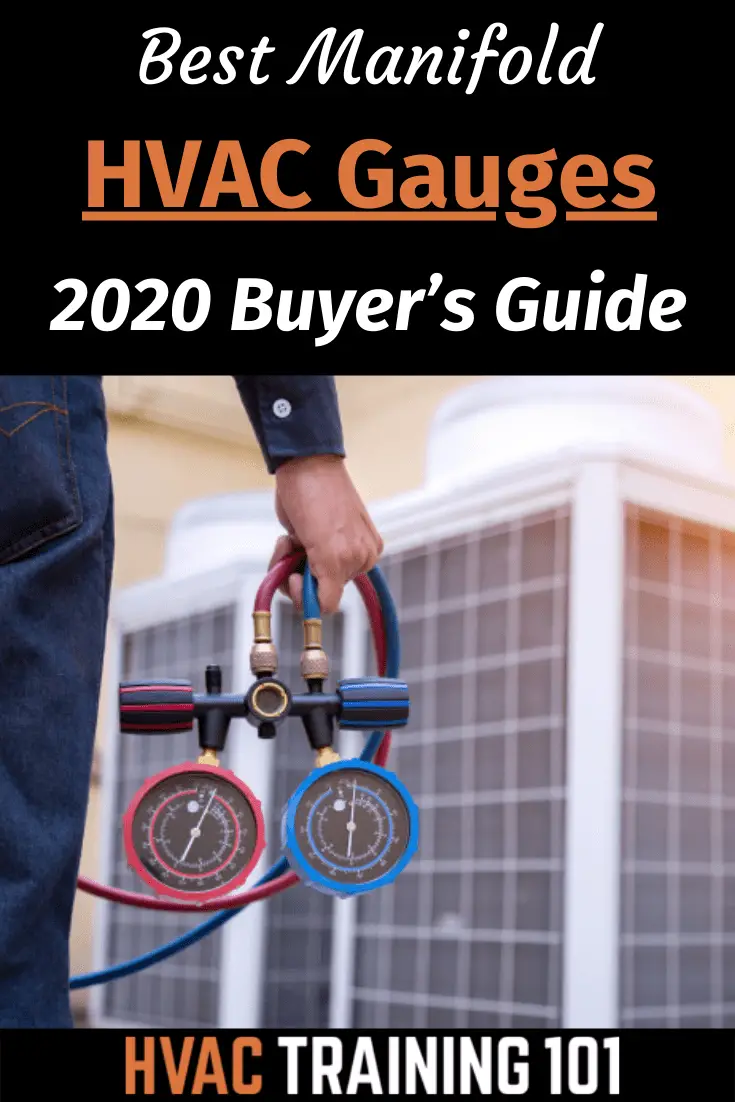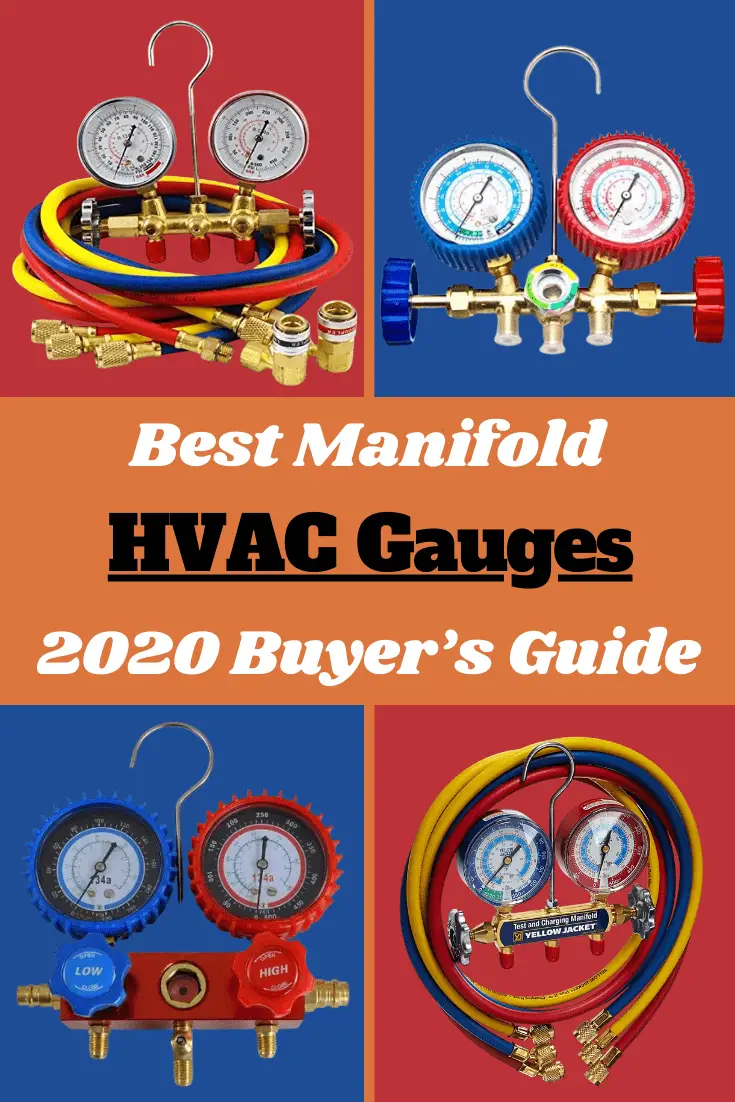Are you a DIY person?
Would you like to know more about how you can improve your air conditioning system?
If you have answered yes to either of these questions, perhaps it is time you looked into air conditioning manifold gauges. Whether you are trying to get some HVAC work done for your home or looking to work with HVAC technicians, having some basic knowledge about gauges is bound to come in handy.
We’ve compiled a list of things you should know about air conditioning manifold gauges and a list of products we recommend, so scroll down for more information on air conditioning manifold gauges.
Comparison of the Best HVAC Manifold Gauges
| IMAGE | PRODUCT | |
|---|---|---|
OUR TOP PICK  |
| VIEW LATEST PRICE → |
 |
| VIEW LATEST PRICE → |
 |
| VIEW LATEST PRICE → |
 |
| VIEW LATEST PRICE → |
 |
| VIEW LATEST PRICE → |
 |
| VIEW LATEST PRICE → |
 |
| VIEW LATEST PRICE → |
Characteristics of Our Favorite Models
When shopping for a manifold gauge set, there are a few things you should consider. These features are proven and tested in our favorite models, and they include:
Durability
Most manifold gauge sets are made from metal. They use either brass or aluminum, and some are more prone to rust than others. The build quality of the connector fittings and the hoses should also count towards your decision. Plastic fittings tend to wear out faster and develop leaks.
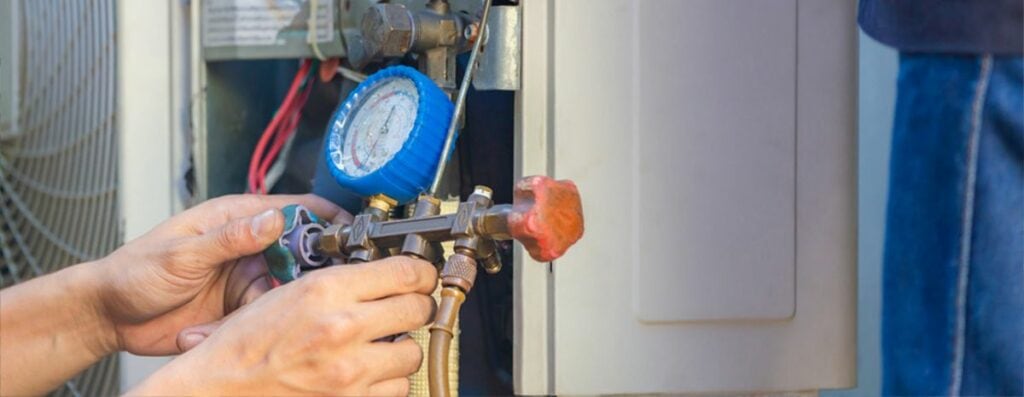
User Friendliness
Your manifold should be easy to connect with quick coupling capabilities. It should also be color coded to help you identify the red for high pressure and blue for low pressure sides. Look for products that come with a comprehensive instruction manual. Hard to use manifold gauge sets will lead to improper connection, leakages, and in some cases, more damage to your AC unit.
Extra Features
Other than the gauges and hoses, look for manifold gauge sets that have extra features such as a sighting glass. They should also come with a can tap included. This is something that you may have to purchase for some units. Any adapters you may require to convert for either R-12 or R-134A units should also be included.
At a Glance: Our Top Picks for HVAC Gauges
Review of the Best HVAC Manifold Gauges
Keep reading below to find more info about each of the gauges mentioned above.
Is there really a “best” model when it comes to air conditioning manifold gauges? We’ve looked into many different models and picked a few to compare and contrast based on user reviews, but the decision is yours.
Above was our quick and dirty list, however, if you want a more in depth look at these models keep reading below.
Best Overall
Mountain 8205 R-134a Brass Manifold Gauge Set with Couplers

Specifications
Manifold Material: Brass
Hose Length: 60″
Refrigerant Compatibility: R-134A
Includes Sight Glass? No
We may earn commission from purchases made from our links, at no additional cost to you
Review
This is an analogue manifold gauge set that works best when used with a brass manifold. The couplers are easy to connect and disconnect, which is something you need if you are working in cramped of poorly lit areas. The manifold and gauges are well made, so you can use them in a repair shop, where there are various AC repair and maintenance orders. This unit doesn’t come with a can tap, and you’ll have to purchase one to use it. The unit is compatible with the much loved Mastercool 85510 can tap.
Both the manifold and couplers are made from brass and steel. In fact, there are no plastic pieces in the entire ensemble, other than the covers for the gauge dials. This ensures durability and reduces chances of accidental breakage, which happens a lot with plastic (it’s brittle in comparison). The quick disconnect receptacles for both the high and low couplers are located at the front. This allows for easier storage and reduces the chances that dirt and debris finds its way into the connectors.
The gauges are consistent and accurate. They move freely and capture variations in the pressure readings no matter how small. There have been complaints about the couplers giving out after a being in constant use for a few months. Finding the correct replacement connectors is also a bit hard. Most replacement connectors don’t fit, which makes the unit not work at all. Users advise that you get the Robinair R-134A replacement coupler set, which fits well and works perfectly with this unit.
Bottom Line
The durability of this manifold gauge set is something worth talking about. The manifold couplers are made from brass and steel to ensure they remain working for a long time. The hoses are also made from a thick material to allow for long life.
Pros
Easy to use
Reasonably priced
Easy to use and attach
High quality hoses with enough length
Color coded hoses for easy identification
Cons
Replacement Adjustable connectors do not always fit
Runner-up
Robinair 48510 R134a Aluminum Manifold Set with 72″ Hoses

Specifications
Manifold Material: Aluminum
Hose Length: 72″
Refrigerant Compatibility: R-134A
Fitting/Adapter Sizes: 1/2 ACME
Includes Sight Glass? Yes
We may earn commission from purchases made from our links, at no additional cost to you
Review
The Robinair 48510 R134a Aluminum Manifold Set is built for appliances that use R-134A refrigerant, especially those made from 1996 to present. It is a premium product that is made from aluminum to be able to handle the rigors of continued use. It is easy to use thanks to the contoured hand wheels which are easy to grip, and color coded to make them easier to identify. The face seal valves are also sealed and designed so that the seal is tighter, the flow is greatly improved, and the unit undergoes less wear when in use.
It uses a double 0-ring piston design that increase the service life considerably and adds extra reliability. The gauges are accurate, easy to read, and very responsive. There are 3 of them, each measuring about 1/8” and they’re all protected by Lexan lenses. The lenses can take small to moderate damage when in operation and remain intact.
This means you don’t have to worry about accidentally breaking your gauge lenses. This manifold set comes with ½ inch acme fittings included, manual 90 degree fittings, and R-134A hose holders. All this fits nicely into the blow molded carrying case that comes with the purchase. The case makes it easier to put the manifold in storage, with reduced chances of unplanned damage.
It also reduces the chances of insects and debris, including dirt and dust from getting into the hoses and connectors. Some used complain about the gauges being out of calibration. This seems to affect the lower side of the gauge mainly. The price point is also higher than other options in its class range.
Bottom Line
This is an excellent manifold gauge set. The price point and the problems with the low gauge are offset by the connections and bushings, which are all high quality and won’t leak refrigerant when you quick disconnect.
Pros
High build quality
Easy to transport and store
Decently sized 72” hose set
Locally assembled in the USA
Easy to read psi gauges for low and high side pressures
Cons
Priced a bit higher than its competition for the same features
3. Yellow Jacket 42006 Series 41 Manifold

Specifications
Manifold Material: Brass
Hose Length: 60″
Refrigerant Compatibility: R-22/134A/404A
PSI (Working and Burst): 800 Working / 4000 Burst
Includes Sight Glass? No
We may earn commission from purchases made from our links, at no additional cost to you
Review
The Yellow Jacket 42006 Series 41 is a precision manifold gauge set. Its best feature is the gauges that are extremely accurate. They’re rated at 1% accuracy, which makes them ideal for reading critical charge systems. This is also great when working with high precision AC systems. They’re designed to be larger than most of the manifolds in the market, with an easy to read 1/8 inch faces, encased in strong steel cases. The casing protects the glass faces from accidental damage during routine function.
The body is made from a durable forged brass with full porting designed to maximize capacity and increase flow. There are 5 foot color coded hoses included, with standard ¼ inch flare fittings as well. The hoses are rated at 55 bar working pressure, with a 275 bar burst pressure limit. This means they can accommodate various pressure measurements, which is ideal if you’ll be using it on various different AC models.
The hose fitting is exact and you don’t need to keep tightening the connection; there will be no leaks when in use. You should however note that if you plan on using this product for any automotive jobs, you’ll have to purchase quick connect fittings separately. You should also get a screw on can tap, an R-12 to R-134A conversion kit, and a single stage vacuum pump.
The recommended can tap is the Mastercool 85510 and with the Mountain 8201 conversion kit. There have been isolated complaints about hose connection problems, but the major drawback is it doesn’t have a sight glass for monitoring positive flow.
Bottom Line
If you’re looking for superior accuracy, then this is the gauge set to buy. There are a couple of drawbacks. The main one being the number of additional items you have to buy if you’re using this for automotive AC units.
Pros
Value for money
Wide range of applications
Durable and lightweight design
Very accurate pressure gauges
Color coded gauges and 5 foot hoses
Cons
No sight glass
4. Performance Tool W89730 A/C Manifold Test Gauge Kit

Specifications
Manifold Material: Brass
Hose Length: 50″
Refrigerant Compatibility: R-134A
PSI (Working and Burst): 120 Low / 500 High
Includes Sight Glass? Yes
We may earn commission from purchases made from our links, at no additional cost to you
Review
This is a great entry level manifold gauge set. It comes with easy to read and well detailed instructions on how to set up, and the optimum working conditions for the tool. The low pressure side is capable of working at between 0 and 120 psi while the high side goes up to 500 psi. The coupling and fittings are made from brass and come with 50 inch hoses.
The short hose length makes this a compact device that works best in tight spaces. The manifold comes with dummy connectors to protect it from dirt and debris when in storage. It also comes with a convenient protective storage container.
The Performance Tool W89730 A/C Manifold Test Gauge Kit is user friendly and has different color codes to let you know which component goes where. It can be used for different applications and has even been turned into an alternative to a motorcycle carburetor synchronizer.
Simply repurpose 4 of the air valves used in a fish tank to stabilize the vacuum jumps. That said, should you decide to attempt the repurposing, the manufacturers of both products don’t accept liability for any injury or damage.
The pressure gauges are fairly accurate, but it’s not recommended for technicians or people that have to deal with pinpoint readings. There have been concerns about the build quality on some of the components of the manifold, especially connectors. They tend to wear with use.
Bottom Line
This is a great product for use during small jobs. The build quality negates its application for commercial purposes. Be careful not to blow too much in that first use. You’re likely to pop the connectors.
Pros
Efficient durable hoses
Detailed user instructions
Multiple usage applications
User friendly color coded design
Dummy connectors when in storage
Cons
Durability on some of the components has been called into question
5. Cal Hawk Tools CZFCGA Manifold Gauge Set

Specifications
Manifold Material: Glass
Refrigerant Compatibility: R12, R22, R502
Includes Sight Glass? Yes
We may earn commission from purchases made from our links, at no additional cost to you
Review
This is a manifold gauge set recommended for the home mechanic. It’s an excellent tool for automotive air conditioning maintenance. The gauges are also fairly accurate, but not recommended for professional use, which requires more pinpoint measurement.
It comes compatible with both R-12 and R-134A systems, although you may be required to purchase an adapter. The entire set doesn’t come with instructions, and may require a little prior experience before using.
The gauges are large and easy to read, which a useful feature, especially if you’re working in low light areas. The hoses are made of silicon for better durability and environmental friendliness. It has a quick disconnect feature with a clever turning knob that protects the internal Schroder valves on the high and low pressure hose.
The body and housing are durable enough for in-home use and small jobs, but will come apart with the rigors of a professional operation. You can choose between two compact space saving storage options; using the blow-molded case, or hanging on the wall using the hook that comes with the product.
There have been complaints of leaks on the yellow hose, which have been attributed to an improperly fitting connection. This can however be rectified by getting a more expensive can tap that has a ¼ inch outlet, or getting a ½ inch to ¼ inch conversion adapter to use with the can tap that came with the manifold. There have also been complaints that the product came with R-12 hoses and R-134A connectors, which made it difficult to set up.
Bottom Line
This is another manifold that’s ideal for small jobs, or for the novice mechanic. It works well with automotive AC maintenance, but the connector fittings cannot handle continuous brutal use. The problem with the yellow hose connector is something to take note of.
Pros
Easy to use
Can be used with an adapter
Accurate gauges and recharges well
Durable hose design with silicon tubing
Comes with a hanging hook for easy storage
Cons
Yellow hose leaks have been reported
6. AJ Tools CHIMG777 Manifold Gauge Set

Specifications
Manifold Material: Brass
Hose Length: 36″
Refrigerant Compatibility: R-410a, R-12, R-22
PSI (Working and Burst): 500 Burst
Includes Sight Glass? Yes
We may earn commission from purchases made from our links, at no additional cost to you
Review
This is a well-priced manifold gauge set that works efficiently with automotive Air conditioning maintenance and other routine repairs. It also connects to home AC systems easily. It comes with a host of nifty features, such as quick connect fittings which save on time. This is also a good quality for the budding mechanic, since it eliminates all the complicated steps. The components are color coded to make the manifold easier to use. This includes the valves, gauges and hoses, which is a clever addition. The unit comes with a sight glass as well.
It comes with a high pressure safety valve which protects the high pressure side from damage and leakage. The valve handles are plastic and are bound to break after continuous use. This makes this product unsuitable for a professional mechanic or HVAC repairman. It doesn’t come with a user’s instruction manual, and you might have to go through a period of trial and error.
The AJ Tools CHIMG777 Manifold Gauge Set is compatible with both R-12 and R-134A systems, with the gauge fairly accurate in reading both. The hoses are short (about 40 inches) which make this an ideal manifold to work with in cramped spaces. It also takes up less space in storage. There have been problems reported with the lower pressure side valve. It’s prone to developing leaks after continuous use. On rare occasions, the gauges are stuck at 20 psi, which throws off your readings.
Bottom Line
This is a useful product. The desirable qualities are however cancelled out by the brittle design of the valve handles and the connectors. That said, the price point justifies investing in the manifold gauge set.
Pros
Reasonably well priced
Multiple user applications
Compact lightweight design
Excellent automotive repair tool
User friendly and efficient design
Cons
Problems reported with the low pressure side valve
7. Biltek HVAC R12 R22 R502 A/C Diagnostic Manifold Gauge Kit

Specifications
Manifold Material: Glass
Hose Length: 60″
Refrigerant Compatibility: R12, R22 & R502
PSI (Working and Burst): 500 Working / 2500 Burst
Fitting/Adapter Sizes: 1/4″ SAE
Includes Sight Glass? Yes
We may earn commission from purchases made from our links, at no additional cost to you
Review
This is a multi-purpose manifold gauge set that works as a complete diagnostic and service tool for both automotive and home air conditioning units. It comes with quick connect couplers with connect fittings. A high pressure valve reduces the chances of leaks. It also has a 10 amps charging rate which is rather high. This unit works with R-12, R-22, and R-502 refrigerants but you might need to get separate specialized equipment to use with R134A systems.
It’s a product that works well for novice mechanics, because of the easy to use quick connectors. The measurement units on the gauge are metric (Celsius), so don’t forget to make any necessary conversions. The 5 feet of hose give you enough room to work with, especially if it’s your first DIY project. You should be prepared for the refrigerant to spray out when you disconnect from your air conditioning. The spray is very cold and could injure your skin. It’s why you’re advised to always wear gloves when doing any sort of maintenance work.
There have been some complaints about the connectivity of the red hose. The red hose has trouble threading into the fitting unit. In some instances, the red hose connects, but develops a leak after a few uses. This can be sorted by purchasing a heavy duty connector for the unit. The build quality has also been called into question. The metal parts of the manifold gauge set tend to wear out rather quickly, and even accrue rust in some places.
Bottom Line
The price point on this manifold gauge set justified its purchase. It works well and the hoses are well built, so they last quite a while. The metal bits are rather susceptible to rusting, and the unit should be stored in a dry place.
Pros
5 feet hose length
High burst pressure rating
High pressure safety valve
10 amps high rate charging
Measurements are in Celsius
Cons
Poor red hose threading with the fitting
8. FJC 6761 R134a Aluminum Manifold Gauge Set

Specifications
Manifold Material: Aluminum, Glass
Hose Length: 72″
Refrigerant Compatibility: R12, R-134A
Includes Sight Glass? Yes
We may earn commission from purchases made from our links, at no additional cost to you
Review
The FJC 6761 R134a Aluminum Manifold Gauge Set is made from an aluminum body, which makes it both lightweight and durable. It comes with a sight glass, so you can monitor every stage of operation. It features a fast assembly design that requires no wrenches to put together. The quick couplers allow you to quickly fit it to the vacuum unit. It also comes with an additional access port.
The manifold gauge set is only made for the R-134A systems, which is what has been fitted in most vehicles made after 1993. If you’re a motor vehicle collector or own a car made before 1993, you’ll need to get an R-12 adapter. It comes with a well-detailed and informative instruction manual. This will help you get orientated with the product, how to put it together, how to clean it, and how to correctly use it. It also shows how to safely store it in the right conditions and away from debris.
On first use, you may need to bleed the air through the fittings to ensure that you are sending Freon alone into the system. This part is not included in the instructions. If you have correctly connected everything and the Freon is still not getting to the system, you may need to turn the Freon can upside down. This is an old trick that mechanics use to get things going.
The product unboxing should be done in the garage with the door open. This is because there’s a strong plastic smell from the hoses when new, which might irritate some people. The smell takes a few minutes to dissipate.
Bottom Line
This is a value for money manifold gauge set. It does everything as well as advertised, but has no extra features. The connector fittings will wear out after a while, and that is something you may need to replace.
Pros
Relatively well priced
Quick assembly design
Easy to follow instructions
Compatible with quick couplers
Works excellently with automotive air conditioning
Cons
Build quality on the connector fittings is concerning
What is a Manifold Gauge Used For?
The manifold gauge is a must-have for someone looking to work on their HVAC system, as it is the most basic of all air conditioning systems. An air conditioning manifold gauge can be used as a diagnostic tool to check pressure and determine if there is a leak. It can also be used as a service tool to perform recharge and evacuation.
Digital vs. Analog Manifold Gauges
There are two different types of air conditioning manifold gauge – analog and digital – but they are all built on the same principal. They are used to remove contaminated refrigerant to decrease the rates of cross-contamination, or to recharge your air conditioning system to keep your system working.
Digital manifold gauges have been around for some time and their popularity has been on the rise recently, as they are capable of providing fast and accurate readings. There is much debate going on in the HVAC community about using digital manifold gauges, so we researched the pros and cons of digital manifold gauges vs. analog manifold gauges.
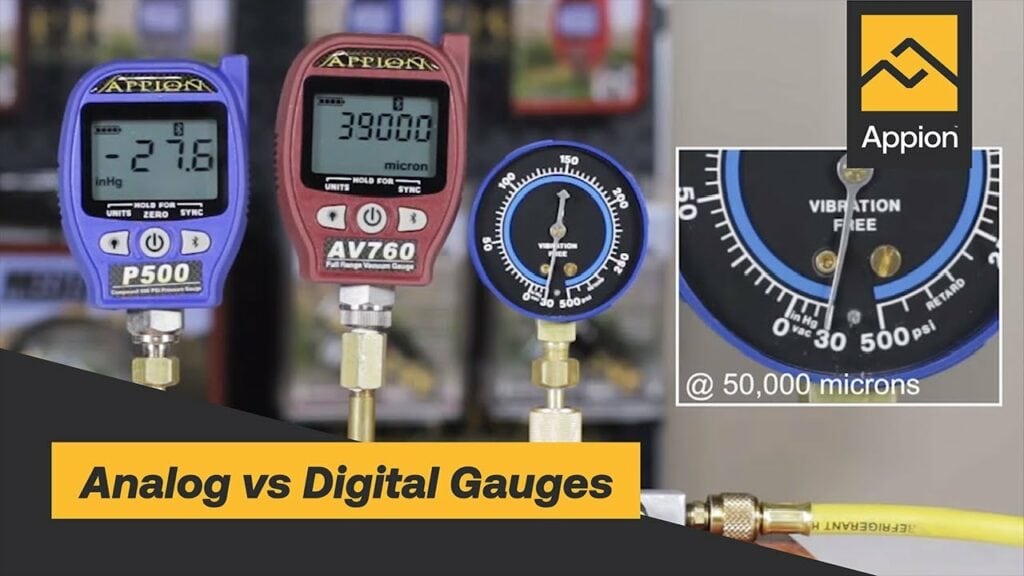
Analog Manifold Gauge Pros and Cons
First, the pros of analog manifold gauges are that they have been used for generations, and are a tried and true method. Seasoned technicians are able to read this type of gauge easily without even referring to a chart. The cons of analogue manifold gauges are that they can be difficult to read, and technicians are more likely to misinterpret this gauge, as it is more prone to conversion errors.
Digital Manifold Gauge Pros and Cons
The pros of digital manifold gauges are that they are really easy to read and require no conversion table, as they come equipped with P/T charts and thermometers. Digital manifold gauges are also very accurate.
The cons of digital manifold gauges include the upfront cost, as they are more expensive than their analogue counterparts, but it may be worth it in the long run and for their convenience. They are also less durable and heavier, and may require extensive training for HVAC technicians not used to digital manifold gauges. Digital manifold gauges are also not immune to computing failure in the system, and albeit rare, this could lead to a misreading.
How to Calibrate Manifold Gauges
Users that have prior experience with calibrating manifold gauges may not find it to be such a hard task. But those that don’t may not quite understand the process. If you too are new to these products, then do not worry. Here is a step by step guide on how to calibrate your manifold gauge.
1.Before you start, you need to make sure that you have all the required items for the process. These include an adjusting screwdriver, pressure-temperature chart and a thermometer, canister with refrigerant, and of course, your manifold gauge set.
2. Once you have gathered all the items, you need to zero your gauges. For that purpose, you need to bring the gauge at ambient pressure. To do that, you will have to remove the hose and then release the valve.
3. Once brought to the ambient pressure, you can set your gauge to zero. For that, reach the adjustment screw and use the screwdriver to bring the needle to rest at zero. Once the needle is at zero, your gauge is calibrated.
It is a simple process that takes only three steps. If you still have any further questions, feel free to refer to the video below for a better illustration.
Conclusion
There are many factors to consider when getting a new air conditioning manifold gauge, as it plays a pivotal role in diagnosing and fixing air conditioning systems.
This article compared and contrasted the pros and cons of digital and analog gauges and compiled a list of manifold gauge sets you may be interested in looking to streamline the decision process, but it is up to you to make the decision and find the gauge set you really like. We sincerely hope this article was helpful in assisting you in the process.
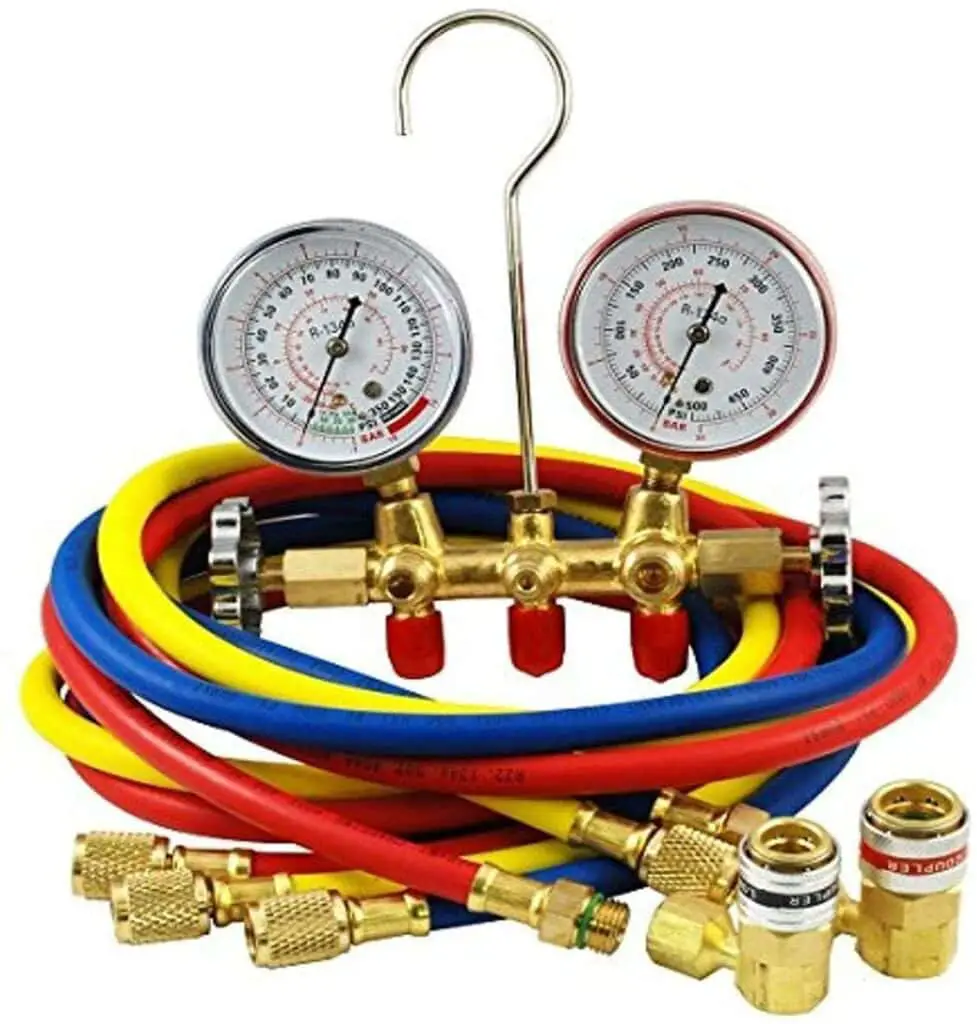
People Also Ask
When it comes to choosing a manifold gauge set to suit your needs, having the right information can make all the difference. For instance, there are certain questions that are asked frequently by customers. These include questions include about the Freon systems that work with the manifold gauge set, and whether it comes with a sight glass. There are however two important pieces of information you should have before you purchase one. These are:
To use HVAC manifold gauges, there are four main steps to follow.
1. Connect the high pressure side to the red port on the gauge. It’s important to note that the red gauge is always designated for high pressure. Most manufactures make this side a different size – with different threading – to avoid mix ups.
2. Connect the low pressure side to the blue fitting on the gauge. It will be attached to the low pressure side of the air conditioning unit using the blue hose. This allows for vacuum pressure to flow properly so you can determine the current amount of pressure in the system.
3. Affix a vent hose to the center of the manifold gauge set. If you aim to vent a Freon unit, you will need to attach the low pressure hose. This will allow you to attach a refrigerant recovery receptacle, since it is a federal crime to release refrigeration chemicals and gases into the atmosphere.
4. Attach all the other gauges including micron meters.
Reading AC gauges is easy once you know what to look out for. The main focus is on the hand valve, since its opening and closing controls everything. To open the hand valve, you rotate the small needle located on the AC assembly. It’s rotated clockwise to open and counterclockwise to close.
To get the right reading, you must first calibrate the AC gauge. To do this, remove all the hoses from the chambers. You then open the high and low valves on the manifold gauge set and once you remove the covers, you can access the calibration screws. Make the required adjustments and make sure the needle starts at zero.
The basic design of these gauges is always the same, but what varies is the material used for their construction. Even though different manufacturers use different materials, there are two materials that are more commonly used. These include brass and aluminum, which provide the ideal qualities for the function.
Reading the values on a gauge can be very tricky, especially if it’s an analog gauge. But with a digital one, the job is made easier. A digital HVAC gauge directly provides you the readings for pressure and other parameters being measured. So all you really need to do is read the number off the screen.
Disconnecting the manifold gauge is an easy job. Make sure you have your protective gear on. Shut off the lower valve and remove it from the source. Start releasing the valve and wait until both sides are equal. Once they are, close the suction valve and pull it out. Your gauge is now disconnected with minimal loss of refrigerant.
Share to Pinterest
